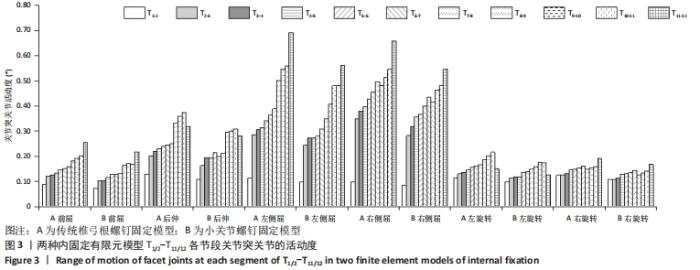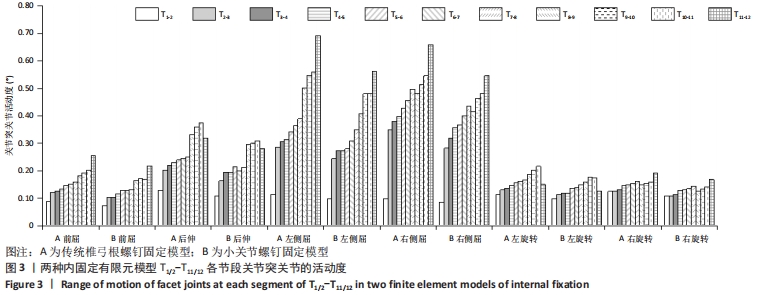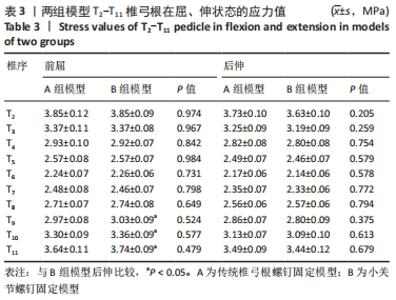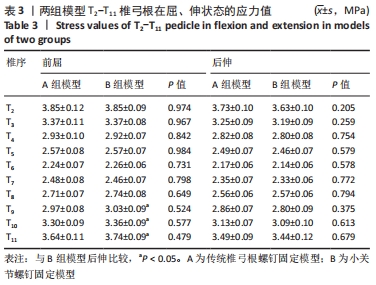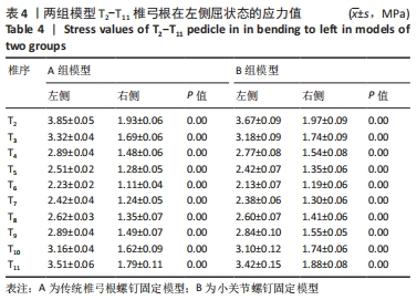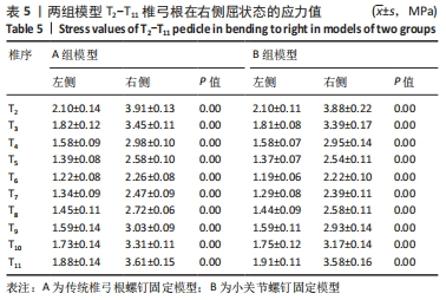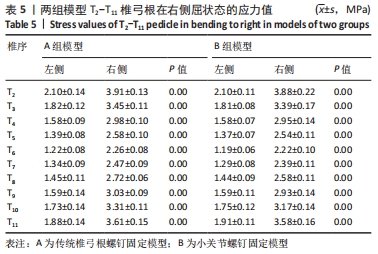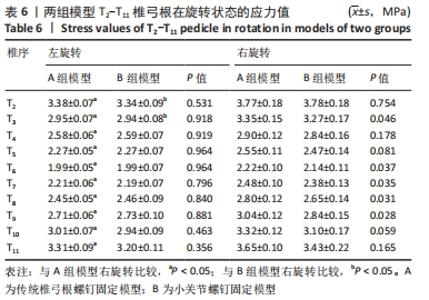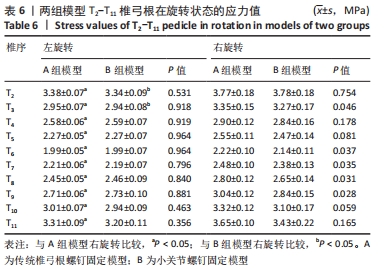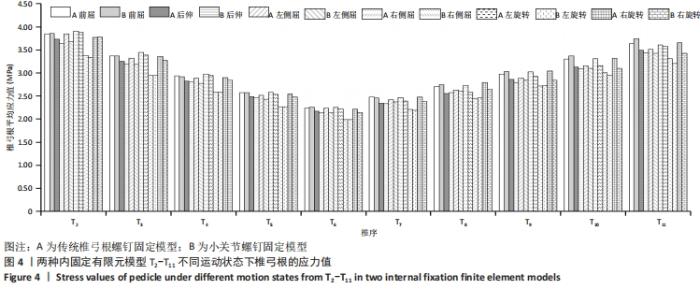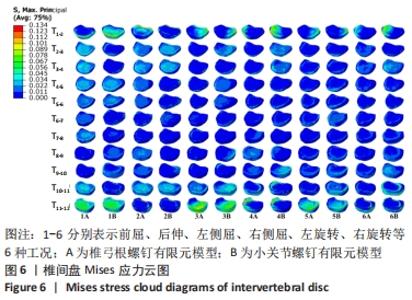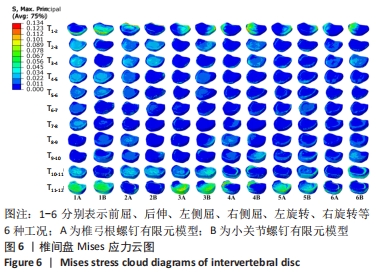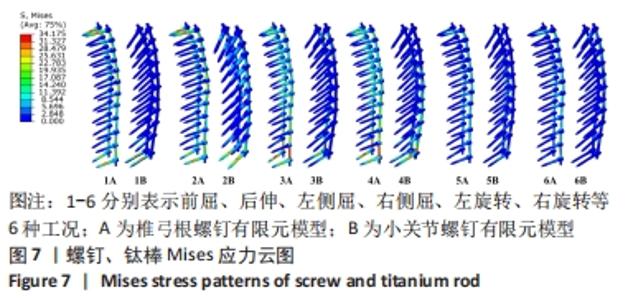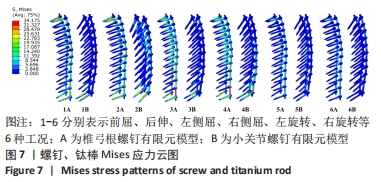Chinese Journal of Tissue Engineering Research ›› 2023, Vol. 27 ›› Issue (9): 1365-1370.doi: 10.12307/2022.803
Previous Articles Next Articles
Finite element analysis of transarticular screw fixation of adolescent thoracic vertebra
He Yujie1, Kang Zhijie2, Xue Mingming3, Jin Feng4, Li Zhijun1, Wang Xing1, Xu Yangyang5, Gao Mingjie1, Li Jiawei2, Li Xiaohe1, Wang Haiyan1
- 1Department of Human Anatomy of School of Basic Medicine, 2Graduate School, 3Department of Physiology of School of Basic Medicine, 4Department of Imaging of Affiliated Hospital, Inner Mongolia Medical University, Hohhot 010010, Inner Mongolia Autonomous Region, China; 5Department of Rehabilitation, Changzhi People’s Hospital, Changzhi 046000, Shanxi Province, China
-
Received:2021-08-30Accepted:2022-01-07Online:2023-03-28Published:2022-07-01 -
Contact:Wang Haiyan, Professor, Master’s supervisor, Department of Human Anatomy of School of Basic Medicine, Inner Mongolia Medical University, Hohhot 010010, Inner Mongolia Autonomous Region, China Li Xiaohe, Professor, Master’s supervisor, Department of Human Anatomy of School of Basic Medicine, Inner Mongolia Medical University, Hohhot 010010, Inner Mongolia Autonomous Region, China -
About author:He Yujie, Lecturer, Department of Human Anatomy of School of Basic Medicine, Inner Mongolia Medical University, Hohhot 010010, Inner Mongolia Autonomous Region, China Kang Zhijie, Master candidate, Graduate School, Inner Mongolia Medical University, Hohhot 010010, Inner Mongolia Autonomous Region, China He Yujie and Kang Zhijie contributed equally to this article. -
Supported by:National Natural Science Foundation of China, No. 81860383 (to LZJ); the National Natural Science Foundation of China, No. 81860558 (to JF); the Natural Science Foundation of Inner Mongolia Autonomous Region, No. 2021MS08086 (to WHY); Undergraduate Scientific and Technological Innovation “Elite Cultivation” Project of Inner Mongolia Medical University in 2020, No. YCPY20200015 (to WHY); Undergraduate Scientific and Technological Innovation “Elite Cultivation” Project of Inner Mongolia Medical University in 2020, No. YCPY20200018 (to HYJ); “Enlightenment Program” Project of the First Clinical Medical College of Inner Mongolia Medical University in 2020, No. FYQMJH2020033 (to WHY); “Trinity” Innovation and Entrepreneurship Cultivation Project of Inner Mongolia Medical University in 2020, No. SWYT2020025 (to WHY); “Trinity” Innovation and Entrepreneurship Cultivation Project for College Students of Inner Mongolia Medical University in 2020, No. SWYT2020021 (to HYJ); School-level Scientific Research Project “Achievement Transformation” Project of Inner Mongolia Medical University in 2020, No. YKD2020CGZH009 (to WHY); College Students Innovation and Entrepreneurship Training Program of Inner Mongolia Autonomous Region, No. 201910132019 (to WHY); Science and Technology Development Plan Project of Inner Mongolia Autonomous Region, No. 2019GG115 (to LZJ)
CLC Number:
Cite this article
He Yujie, Kang Zhijie, Xue Mingming, Jin Feng, Li Zhijun, Wang Xing, Xu Yangyang, Gao Mingjie, Li Jiawei, Li Xiaohe, Wang Haiyan. Finite element analysis of transarticular screw fixation of adolescent thoracic vertebra[J]. Chinese Journal of Tissue Engineering Research, 2023, 27(9): 1365-1370.
share this article
Add to citation manager EndNote|Reference Manager|ProCite|BibTeX|RefWorks
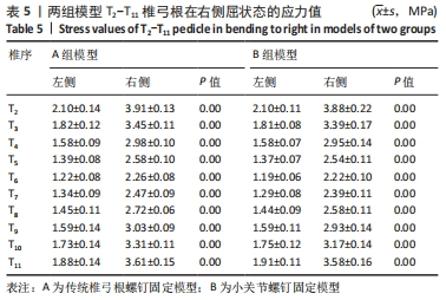
2.4 上关节突关节面应力值 前屈、后伸和侧屈运动状态时,A、B两组模型上关节突的应力值组间比较差异均无显著性意义(P > 0.05);左旋转、右旋转状态时,差异有显著性意义(P < 0.05)的节段分别位于T10和T8,且B组模型上关节突关节面应力值均大于A组。 两组模型的上关节突关节面应力值在6种工况运动状态下,均是左侧屈>右侧屈>后伸>左旋转>右旋转>前屈,均随椎序的递增走势呈“U”形,谷值均为前屈状态下T6[A组模型(0.12±0.20) MPa;B组模型(0.02±0.02) MPa],峰值均为左侧屈状态下T2[A组模型(3.91±0.18) MPa;B组模型(3.78±0.19) MPa],见图5。 "
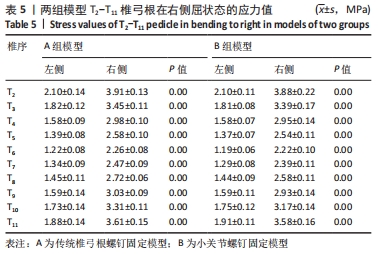
| [1] PICCONE L, CIPOLLONI V, NASTO LA, et al. Thoracolumbar burst fractures associated with incomplete neurological deficit in patients under the age of 40: Is the posterior approach enough? Surgical treatment and results in a case series of 10 patients with a minimum follow-up of 2 years. Injury. 2020;51(2):312-316. [2] WANG TN, WU BL, DUAN RM, et al. Treatment of Thoracolumbar Fractures Through Different Short Segment Pedicle Screw Fixation Techniques: A Finite Element Analysis. Orthop Surg. 2020;12(2):601-608. [3] YU Y, XIE Y, JIAN Q, et al. Biomechanical analysis and optimization of screw fixation technique for the cortical bone channel of lower thorax: Study protocol clinical trial (SPIRIT Compliant).Medicine (Baltimore). 2020;99(7):e19046. [4] SPIRIG JM, HÜLLNER M, CORNAZ F, et al. Cross-links in posterior pedicle screw-rod instrumentation of the spine: a systematic review on mechanical, biomechanical, numerical and clinical studies. Eur Spine J. 2021;30(1):34-39. [5] DENIS F. Spinal instability as defined by the three-column spine concept in acute spinal trauma. Clin Orthop Relat Res. 1984;(189):65-76. [6] QIHANG SU, CONG LI, YONGCHAO LI, et al. Analysis and improvement of the three-column spinal theory. BMC Musculoskelet Disord. 2020;21(1):537. [7] HEGGENESS MH, ESSES SI. Translaminar facet joint screw fixation for lumbar and lumbosacral fusion. A clinical and biomechanical study. Spine (Phila Pa 1976). 1991; 16(6 Suppl):S266-269. [8] YU Y, XIE N, SONG S, et al. A biomechanical coMParison of a novel thoracic screw fixation method: transarticular screw fixation vs traditional pedicle screw fixation. Neurosurgery. 2011;69:141-146. [9] GOEL A, PRASAD A, SHAH A, et al. Transarticular Fixation Following Mobilization of “High-Riding” Vertebral Artery. Oper Neurosurg (Hagerstown). 2021;20(4):E322-E325. [10] DU HG, PHUOC VX, HOANG ND, et al. Transarticular Screw Fixation in the Treatment of Severe C1-C2 Dislocation: A Case Series Report. Orthop Surg. 2020;12(6):2031-2040. [11] HU Y, ZHU BK, YUAN ZS, et al. Anatomic study of the lumbar lamina for safe and effective placement of lumbar translaminar facet screws. J Int Med Res. 2019;47(10):5082-5093. [12] 谭家昌,郑立,赵劲民. 腰椎经椎板关节突螺钉内固定术的应用进展[J]. 微创医学, 2018,13(2):193-196. [13] 肖永川,许泽川,梁川东,等. 腰1椎体应力的有限元分析及分区[J]. 中国脊柱脊髓杂志, 2020,30(11): 1016-1026. [14] LIANG Y, CAO Y, GONG Z, et al. A finite element analysis on coMParing the stability of different posterior fixation methods for thoracic total en bloc spondylectomy. J Orthop Surg Res. 2020;15(1):314. [15] LIAO JC. IMPact of Osteoporosis on Different Type of Short-Segment Posterior Instrumentation for Thoracolumbar Burst Fracture-A Finite Element Analysis.World Neurosurg. 2020;139:e643-e651. [16] LI J, ZHANG LC, LI J, et al. A Hybrid Uniplanar Pedicle Screw System with a New Intermediate Screw for Minimally Invasive Spinal Fixation: A Finite Element Analysis. Biomed Res Int. 2020;2020:5497030. [17] LIU H, WANG H, LIU J, et al. Biomechanical coMParison of posterior intermediate screw fixation techniques with hybrid monoaxial and polyaxial pedicle screws in the treatment of thoracolumbar burst fracture: a finite element study. J Orthop Surg Res. 2019;14(1):122. [18] CAI M, XIN Z, KONG W, et al. Clinical effect of a novel transpedicular reducer for reduction and bone grafting combined with pedicle screw fixation for thoracolumbar burst fractures. BMC Musculoskelet Disord. 2021;22(1):540. [19] 叶建东,程哲,王剑龙. 腰椎融合术3种内固定方式的生物力学特点[J]. 医用生物力学,2021,36(2):208-215. [20] MCLAIN RF, FRY MF, MOSELEY TA, et al.Lumbar pedicle screw salvage:pullout testing of three different pedicle screw designs. J Spinal Disord. 1995;8(1):62-68. [21] GUVENC Y, AKYOLDAS G, SENTURK S, et al. How to Reduce Stress on the Pedicle Screws in Thoracic Spine?Importance of Screw Trajectory:A Finite Element Analysis. Turk Neurosurg. 2019;29(1):20-25. [22] CHONG XL, KUMAR A, YANG EWR, et al. Incidence of pedicle breach following open and minimally invasive spinal instrumentation: A postoperative CT analysis of 513 pedicle screws applied under fluoroscopic guidance. Biomedicine (Taipei). 2020;10(2):30-35. [23] 赵红勇,刘观燚,徐荣明,等. 胸椎后路经关节螺钉拔出力的实验研[J]. 中国骨与关节损伤杂志,2011,26(11):992-994. [24] RODRIGUEZ-MARTINEZ NG, SAVARDEKAR A, NOTTMEIER EW, et al. Biomechanics of transvertebral screw fixation in the thoracic spine: an in vitro study. J Neurosurg Spine. 2016;25(2):187-192. [25] SU Y, WANG X, REN D, et al. A finite element study on posterior short segment fixation combined with unilateral fixation using pedicle screws for stable thoracolumbar fracture. Medicine (Baltimore). 2018;97(34):e12046. [26] INOUE N, ORÍAS AAE, SEGAMI K.Biomechanics of the Lumbar Facet Joint. Spine Surg Relat Res. 2019;4(1):1-7. [27] 张云飞,龚幼波,杜敏. 胸腰椎骨折椎弓根钉置入内固定在不同运动状态的有限元分析[J]. 中国医刊,2021,56(1):41-45. [28] ZHOU Y, XIN D, LEI Z, et al. Comparative Three-Dimensional Finite Element Analysis of 4 Kinds of Pedicle Screw Schemes for Treatment of Adult Degenerative Scoliosis. Med Sci Monit. 2020;26:e922050. [29] ZHANG W, ZHAO J, LI L, et al. Modelling tri-cortical pedicle screw fixation in thoracic vertebrae under osteoporotic condition: A finite element analysis based on computed tomography. Comput Methods Programs Biomed. 2020;187:105035. |
| [1] | Peng Zhixin, Yan Wengang, Wang Kun, Zhang Zhenjiang. Finite element analysis and structural optimization design of 3D printed forearm braces [J]. Chinese Journal of Tissue Engineering Research, 2023, 27(9): 1340-1345. |
| [2] | Wu Tianliang, Tao Xiuxia, Xu Hongguang. Influence of different bone mineral densities on cage subsidence after stand-alone oblique lateral interbody fusion: three-dimensional finite element analysis [J]. Chinese Journal of Tissue Engineering Research, 2023, 27(9): 1352-1358. |
| [3] | Liu Jinyu, Zhang Hanshuo, Cui Hongpeng, Pan Lingzhi, Zhao Boran, Li Fei, Ding Yu. Finite element biomechanical analysis of minimally invasive treatment of cervical spondylotic myelopathy and accurate exercise rehabilitation [J]. Chinese Journal of Tissue Engineering Research, 2023, 27(9): 1359-1364. |
| [4] | Wen Xinghua, Ding Huanwen, Cheng Kai, Yan Xiaonan, Peng Yuanhao, Wang Yuning, Liu Kang, Zhang Huiwu. Three-dimensional finite element model analysis of intramedullary nailing fixation design for large femoral defects in Beagle dogs [J]. Chinese Journal of Tissue Engineering Research, 2023, 27(9): 1371-1376. |
| [5] | Liu Qinghua, Cai Yongqiang, Jin Feng, Yu Jinghong, Wang Haiyan, Zhang Yunfeng, Wang Lidong, Li Jiawei, Wang Xing, He Yujie, Dai Lina, Wang Jianzhong, Wu Chao, Tong Ling, Kang Zhijie, Li Zhijun, Li Xiaohe. Finite element model of the 12-year-old child whole cervical spine: establishment and validity verification based on CT data [J]. Chinese Journal of Tissue Engineering Research, 2023, 27(4): 500-504. |
| [6] | Zhou Changjun, Long Shengli, Zou Wei, Xiao Jie, Long Hao, Feng Mingxing, Zhang Yang, Liu Jie, Zeng Zhongwei. Design and clinical application of coplanar screw guide for percutaneous pedicle screw in the treatment of thoracolumbar fracture [J]. Chinese Journal of Tissue Engineering Research, 2023, 27(4): 534-538. |
| [7] | Bao Kai, Song Wenhui, Liu Changwen, Liang Kaiheng, Wang Jiajia. Posterior single-segment pedicle screw fixation for unstable atlas fractures [J]. Chinese Journal of Tissue Engineering Research, 2023, 27(4): 594-599. |
| [8] | Lu Hui, Wu Qimei, Liu Rong. Finite element analysis and application of unilateral and bilateral bone-filling mesh container in treatment of osteoporotic vertebral compression fracture [J]. Chinese Journal of Tissue Engineering Research, 2023, 27(3): 391-397. |
| [9] | Wei Guoqiang, Li Yunfeng, Wang Yi, Niu Xiaofen, Che Lifang, Wang Haiyan, Li Zhijun, Shi Guopeng, Bai Ling, Mo Kai, Zhang Chenchen, Xu Yangyang, Li Xiaohe. Biomechanical analysis of non-uniform material femur under different loads [J]. Chinese Journal of Tissue Engineering Research, 2022, 26(9): 1318-1322. |
| [10] | Zhang Yufang, Lü Meng, Mei Zhao. Construction and verification of a full spine biomechanical model of adolescent scoliosis [J]. Chinese Journal of Tissue Engineering Research, 2022, 26(9): 1351-1356. |
| [11] | Zhang Jichao, Dong Yuefu, Mou Zhifang, Zhang Zhen, Li Bingyan, Xu Xiangjun, Li Jiayi, Ren Meng, Dong Wanpeng. Finite element analysis of biomechanical changes in the osteoarthritis knee joint in different gait flexion angles [J]. Chinese Journal of Tissue Engineering Research, 2022, 26(9): 1357-1361. |
| [12] | Li Kun, Gao Erke, Xiong Feng, Wang Xing, Wu Danqi, Li Zhijun, Zhang Shaojie, Liu Yanan, Duo Lan, Li Ziyu. Feasibility of axial transpedicle screw internal fixation in children aged 1 to 6 years [J]. Chinese Journal of Tissue Engineering Research, 2022, 26(9): 1383-1387. |
| [13] | Jiang Huanchang, Zhang Zhaofei, Liang De, Jiang Xiaobing, Yang Xiaodong, Liu Zhixiang. Comparison of advantages between unilateral multidirectional curved and straight vertebroplasty in the treatment of thoracolumbar osteoporotic vertebral compression fracture [J]. Chinese Journal of Tissue Engineering Research, 2022, 26(9): 1407-1411. |
| [14] | Yang Jun, Yang Qun, Zhang Rui, Jiang Chang. A novel slidable pedicle screw-rod system for lumbar tuberculosis: promoting bone graft fusion by producing stress stimulation to fused segment [J]. Chinese Journal of Tissue Engineering Research, 2022, 26(6): 914-918. |
| [15] | Guo Xiaohui, Song Xizheng, Xiang Hanrui, Kang Zhaorong, Li Daming, Kang Yu, Hu Jun, Sheng Kai. External spinal fixation elastic stress in the treatment of jumping spinal fracture [J]. Chinese Journal of Tissue Engineering Research, 2022, 26(6): 919-923. |
| Viewed | ||||||
|
Full text |
|
|||||
|
Abstract |
|
|||||
